Abric Romaní Neanderthal shelter
 General view of Abric Romaní. V. Mourre / Wikimedia Commons. CC BY-SA 3.0
General view of Abric Romaní. V. Mourre / Wikimedia Commons. CC BY-SA 3.0
Between 75,000 and 40,000 years ago, the cliff of Capelló was a shelter for Neanderthals, an extinct species of hominid who were organised into small communities of hunter-gatherers. Thousands of years later, Abric Romaní revealed to archaeologists what life was like for a species who shared common evolutionary ancestry with modern man.
In terms of the number and the importance of the findings, Abric Romaní has become one of the principal Middle Palaeolithic sites on the Iberian Peninsula. Thanks to these discoveries, it is possible to reconstruct the modus vivendi of these communities and their interaction with the natural environment in which they lived.
In addition, Abric Romaní, which is still in the process of excavation, has, for the first time allowed us to determine (for Neanderthal groups) the occupation strategies, the structure of their dwellings, subsistence strategies, the technologies of fire and tools, etc. Notable among the remains recovered are scores of wooden objects (the largest collection in the world with such an ancient chronology), close to 200 fireplaces and numerous tools made of stone and bone that demonstrate some very technically advanced production systems.
Abric Romaní forms part of the NEAN-Capellades Prehistoric Park, which includes some 20 archaeological sites in total, and acts as a centre for the dissemination of prehistory and the promotion of cultural tourism.
Plan your visit
What can I do?
A visit to the Capellades Prehistoric Park is centred around a visit to the archaeological site of Abric Romaní. Here, you can also see an exhibition, an audio-visual display about Neanderthals and take part in a spear-throwing and archery workshop.